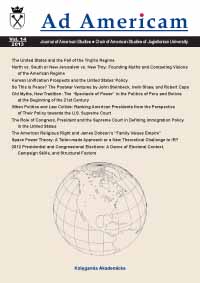2012 Presidential and Congressional Elections: A Dance of Electoral Context, Campaign Skills, and Structural Factors
2012 Presidential and Congressional Elections: A Dance of Electoral Context, Campaign Skills, and Structural Factors
Author(s): Maciej TurekSubject(s): Politics / Political Sciences
Published by: KSIĘGARNIA AKADEMICKA Sp. z o.o.
Summary/Abstract: After significant gains in the 2010 midterm congressional elections, along with succeeding in winning many state and local races, the Republican establishment was waiting for the 2012 presidential and congressional elections with high and justified hopes. As the U.S. economic situation had not recovered the way President Obama had expected, which translated into his rather moderate job approval ratings, Republican presidential nominee Mitt Romney was expected to make Barack Obama a one‑term president. However, as in contemporary presidential campaigns, electoral context alone seems not to be enough to claim the presidency, and other factors intervened which ensured the re‑election of the 44th president of the United States. At the same time, while the same electoral context gave Democrats more votes in congressional elections, somehow it did not give them the majority in the House of Representatives, guaranteeing the status quo from the 2010 cycle. In this paper, the author identifies the main forces behind the results of both presidential and congressional 2012 elections, arguing that while context was vital for the conducting of the campaign, other factors contributed to the contemporary, post‑2012 American political scene. What is important is that the so‑called structural factors in the presidential and congressional election seem likely to make this scene stagnate for many years to come.
Journal: Ad Americam. Journal of American Studies
- Issue Year: 2013
- Issue No: 14
- Page Range: 149-161
- Page Count: 13
- Language: English

